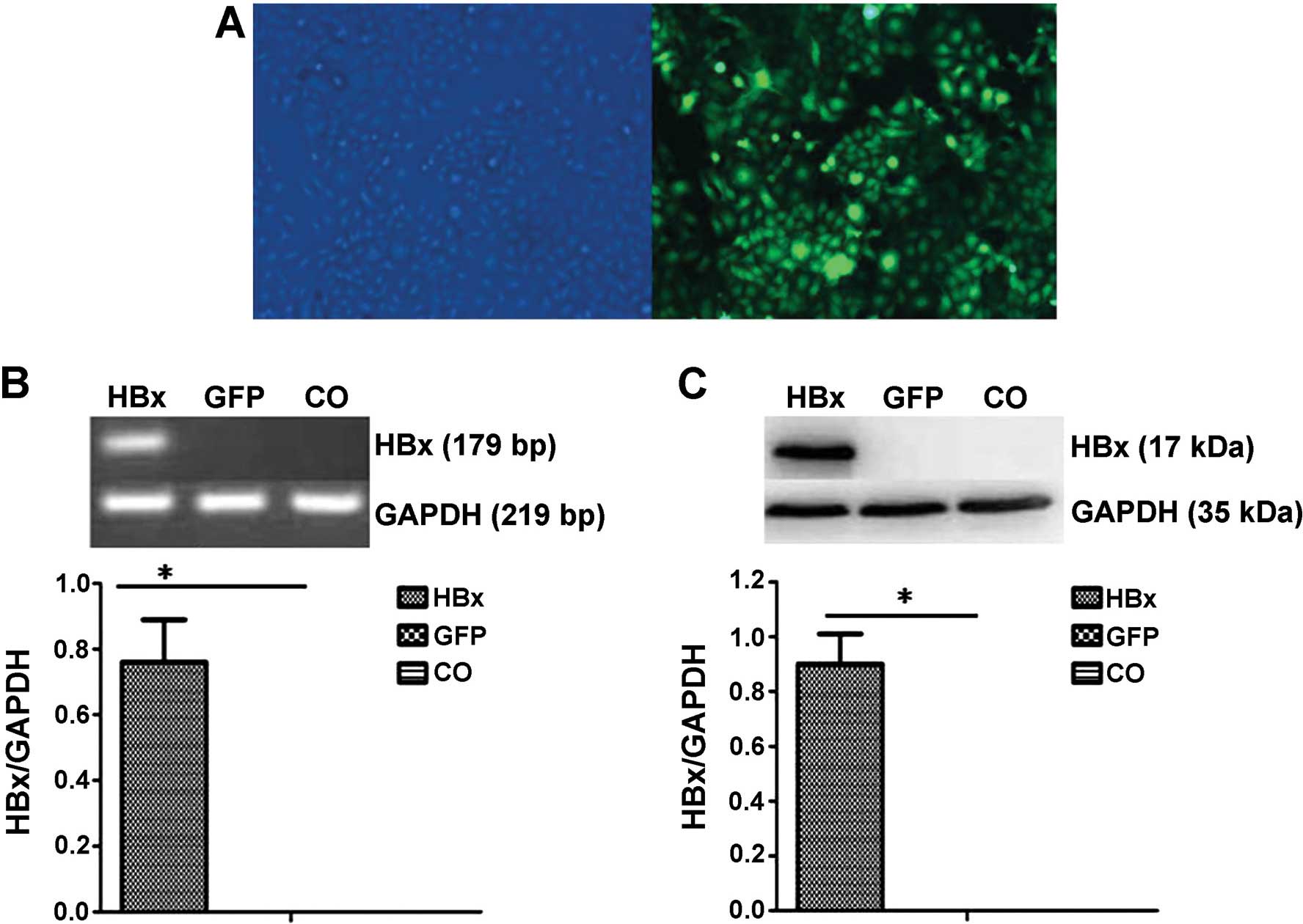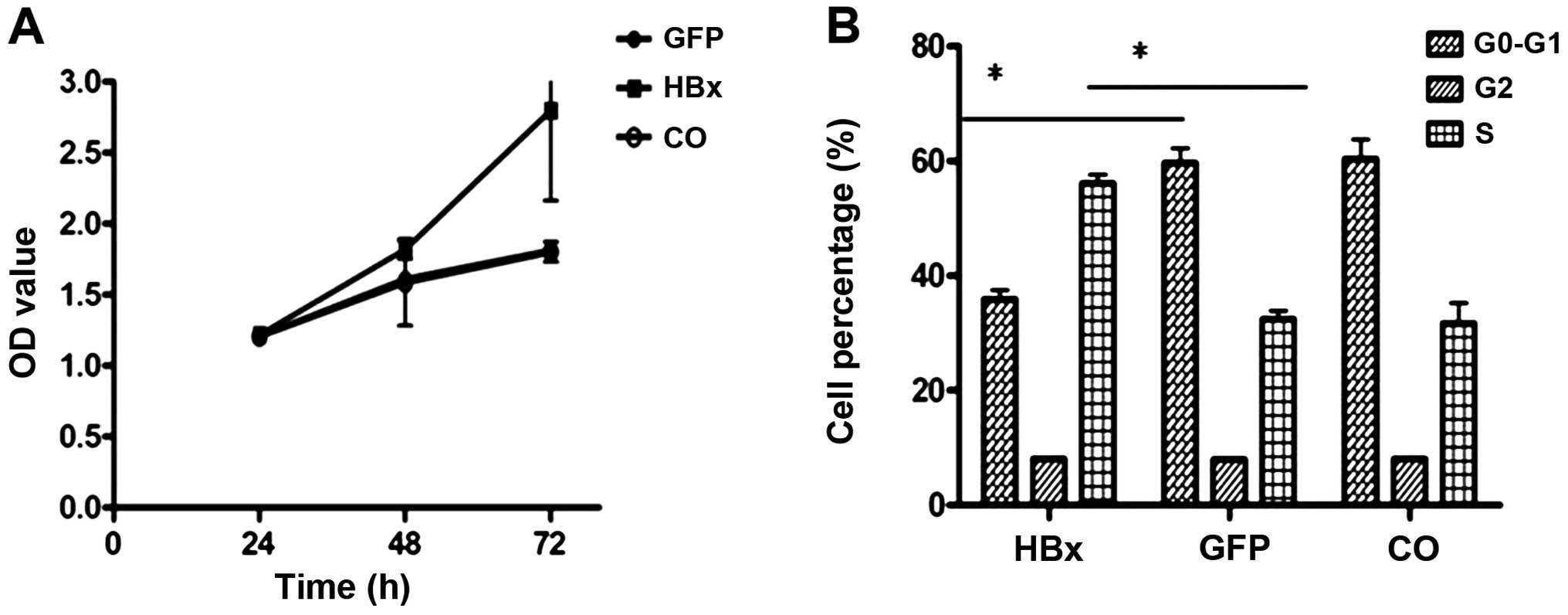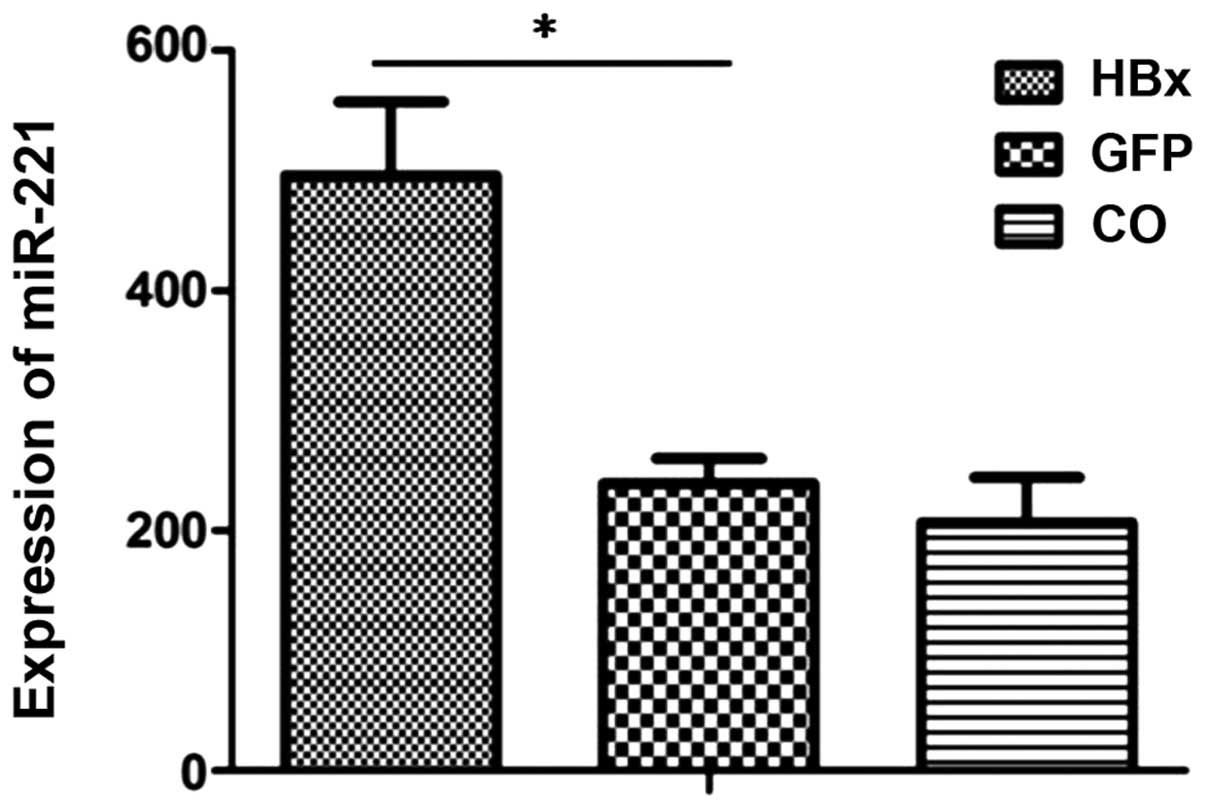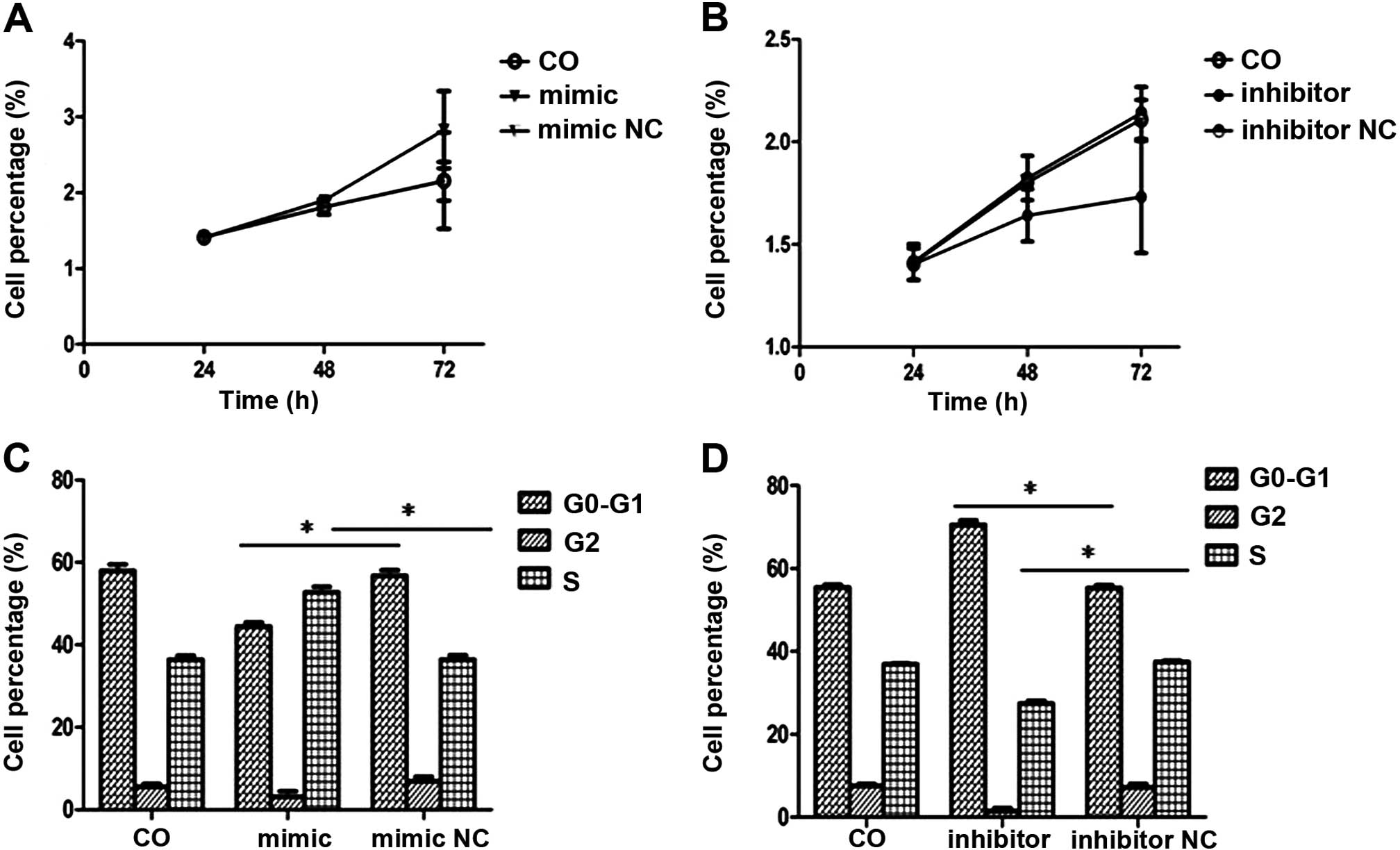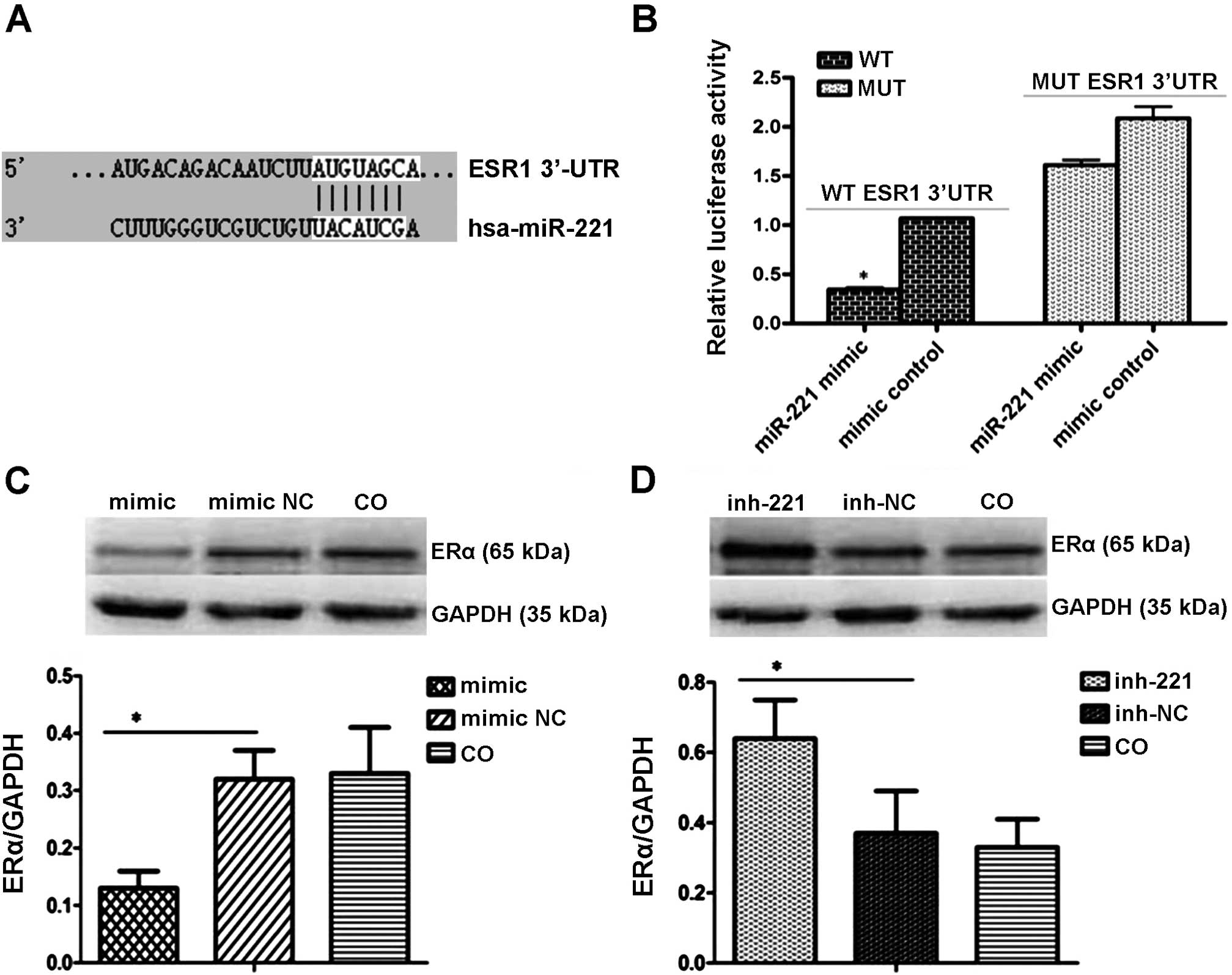HBx protein-induced upregulation of microRNA-221 promotes aberrant proliferation in HBV‑related hepatocellular carcinoma by targeting estrogen receptor-α
- Authors:
- Published online on: December 4, 2014 https://doi.org/10.3892/or.2014.3647
- Pages: 792-798
Abstract
Introduction
Hepatocellular carcinoma (HCC) is a major health concern worldwide and is the main cause of death among cirrhotic patients (1). It is one of the most lethal malignancies in the world with more than half a million new cases diagnosed annually (2). Hepatocarcinogenesis is a complex and multi-step process, which is associated with many risk factors (3). Epidemiological studies have demonstrated that hepatitis B virus (HBV) infection is one of the key risk factors for HCC (4), particularly in eastern Asia.
Hepatitis B virus X (HBx) protein, a 17-kDa protein encoded by the HBV genome, plays a critical role in the progression of HBV-related HCC (5,6). In addition, HBx protein can interfere with several signaling pathways that are associated with cell proliferation and apoptosis. However, the exact role of HBx protein in the progression of HCC remains to be determined. Investigation of the mechanism is important to clarify the tumorigenic pathway and is helpful for developing new biomarkers for early detection and accurate diagnosis.
MicroRNAs (miRNAs) are a class of ~21–25 nucleotide non-coding RNAs, which mediate the post-transcriptional regulation of mRNAs by interfering with mRNA stability or protein translation (7). They have been identified as being involved in biological processes, including cell proliferation, apoptosis as well as cell differentiation (8,9). Deregulation of miRNAs has been found to be essential in cancer development and progression (10). Growing evidence reveals that many miRNAs are involved in HCC tumorigenesis, including miR-221 (11,12). miR-221 upregulation indicates the activation of stellate cells and the progression of liver fibrosis (13).
Previous data indicate that estrogen receptor-α (ERα) has protective effects on HCC (14). The relationship between miR-221 and ERα was studied by Zhao et al (15). They found that miR-221 negatively regulates ERα expression by interaction with the 3′-untranslated region (3′UTR) of ERα in breast cancer. To date, however, the role of miR-221 in HBV-related hepatocarcinogenesis and the molecular mechanisms by which miR-221 modulates malignant phenotypes of HCC cells remain largely unknown.
In the present study, we found that upregulation of miR-221 was unregulated by HBx protein in HCC. The overexpression of miR-221 was found to induce cell proliferation. Finally, an inverse correlation between the expression of miR-221 and ERα was found in HCC. Our findings will help to determine the oncogenic role of miR-221 in hepatocarcinogenesis and the molecular mechanism of HBx protein in the progression of HCC.
Materials and methods
Tissue specimens and cell culture
HepG2 and MCF-7 cells were purchased from the American Type Culture Collection. The HepG2.215 cell line, which persistently produces HBV due to the integrated HBV genome, was kindly provided by Professor Ailong Huang (Key Laboratory of Molecular Biology on Infection Diseases of the Ministry of Education, Chongqing Medical University). The cells were cultured in minimum essential medium (MEM; HyClone) supplemented with 10% (v/v) FCS, 2 mmol/l glutamine, 1 mM sodium pyruvate, 100 U/ml penicillin-streptomycin solution in a 5% CO2 incubator at 37°C.
Fourteen formalin-fixed and paraffin-embedded (FFPE) hepatic tissue specimens were obtained from patients chronically infected with HBV at the First Affiliated Hospital of Chongqing Medical University and were confirmed as HCC by histopathological evaluation. All of the tissue specimens were obtained after consent was obtained by the patients.
Construction of the Ad-HBx adenovirus and the infection of HepG2 cells
Both the Ad-HBx and the control Ad-EGFP adenoviruses were constructed with the AdEasy system. HepG2 cells were plated into a 6-well plate in 2 ml of complete medium at a density of 1.5×105 cells/well and incubated overnight until 30–50% confluency. The Ad-HBx and Ad-EGFP adenoviruses were respectively infected into HepG2 cells at an MOI of 50. The infection efficiency was evaluated by observation of EGFP expression under a fluorescence microscope after 48 h.
Semi-quantitative reverse-transcription PCR
After incubation for 48 h, cells infected with the adenovirus were harvested. Total RNA was then extracted using TRIzol reagent (Invitrogen) and quantified by spectrophotometry at OD260. First-strand cDNA was synthesized using oligo(dT)12-18 primers and SuperScript II RNase H-Reverse Transcriptase (both from Invitrogen) according to the manufacturer’s recommendations. The target cDNA was amplified using Platinum Taq DNA polymerase (Invitrogen) for 28–30 cycles. PCR was performed with the following primers: P1 and P2 for HBx, P3 and P4 for GAPDH: P1, 5′-ACCGACCTTGAGGCCTACTT-3′; P2, 5′-GC TTGGCAGAGGTGAAAAAG-3′; P3, 5′-GAGTCAACGGAT TTGGTCGT-3′; and P4, 5′-TTGATTTTGGAGGGATCT CG-3′. Each sample was then analyzed by electrophoresis, and the resulting gel was photographed using a gel documentation system (Bio-Rad).
miRNA isolation and quantitative reverse transcription-polymerase chain reaction
Total RNA was isolated from HepG2 cells using the mirVana PARIS kit (Applied Biosystems, Inc.) according to the manufacturer’s instructions. Quantification of miR-221 was performed using the TaqMan miRNA assay kit (Applied Biosystems, Inc.) according to the manufacturer’s instructions. U6 small nuclear RNA was used as an internal control for determining the relative miRNA expression level, followed by detection with the Applied Biosystems 7500HT Sequence Detection System (P/N: 4329002) (both from Applied Biosystems). In relation to the expression of small nuclear U6 RNA, the expression level of miR-221 for each RNA sample was calculated, reflected by the value of ΔCt (Ct of miR-221 − Ct of U6).
Western blot analysis
M-PER mammalian protein extraction reagent (Cell Signaling) was employed to lyse the cells. Proteins were resolved on 10% SDS-PAGE gels and transferred to PVDF membranes. The membranes were blocked with 5% BSA, and incubated with antibodies against ERα (R&D Systems) and GAPDH according to the standard western blot protocol. Blots were developed using SuperSignal West Pico chemiluminescent substrate (Pierce), imaged and analyzed using the Bio-Rad Gel Imaging System (Bio-Rad).
Cell transfection
The miR-221 mimic or the miR-221 inhibitor (both from Qiagen, Valencia, CA, USA) was transfected (4.5 μM) with HiPerFect Transfection Reagent (Qiagen) according to the manufacturer’s procedures. Negative control premiR (Qiagen)was also transfected into the HepG2 cells as the control.
Cell growth assay
HepG2 cells (4×103/well) were plated in 96-well plates, and then the cells were transfected (final miRNA concentration of 3 nM), or infected. Cell proliferation was documented every 24 h for 3 days using a cell counting kit (Dojindo), and absorbance at 450 and 610 nm was evaluated using a SpectraMax 190 microplate reader (Molecular Devices, Sunnyvale, CA, USA).
Flow cytometry for cell cycle and apoptosis analysis
For cell cycle analysis, the cells from each well were harvested 48 h after transfection, and then the transfected cells were fixed with 70% cold ethanol for at least 1 h after collecting and washing. Cells were stained with propidium iodide, and cell cycle distribution was examined by a fluorescence-activated cell sorting (FACS) flow cytometer, and DNA histograms were analyzed with modified software.
Luciferase reporter assay
The 3′UTR of the candidate gene was cloned and inserted into the downstream of the luciferase gene in the pGL3/luciferase vector. The mutant 3′UTR of the candidate gene was cloned using the wild-type 3′UTR as a template and inserted into pGL3/luciferase as described for the wild-type 3′UTR. The cells were co-transfected with miRNA mimics and the wild-type or mutant 3′UTR of the candidate gene. Luciferase activity was determined 48 h after transfection using the Dual-Luciferase Reporter Assay system (Promega).
Statistical analysis
All data are expressed as mean ± standard deviation (SD) from at least 3 separate experiments. Statistical significance was determined with the paired Student’s t-test, except as noted for analyses of microarray data, which were examined with Fisher’s exact tests. P-value <0.05 was considered to indicate a statistically significant result. All statistical analyses were performed with SPSS software (version 17.0).
Results
Ad-HBx-transfected HCC cells
HepG2 cells were infected with Ad-HBx core or Ad-GFP at an MOI of 50, and the infection efficiency was evaluated by observation of EGFP expression under a fluorescence microscope (Fig. 1A). We used semi-quantitative reverse transcription-PCR to confirm the infection efficacy of HBx (Fig. 1B). As shown in Fig. 1C, the efficient transient expression of the HBx protein was noted in the HepG2 cells after Ad-HBx infection at 48 h.
HBx promotes HCC cell proliferation
After HepG2 cells were infected with Ad-HBx and Ad-GFP for 48 h, cell proliferation assays indicated significant growth promotion in the Ad-HBx-infected cells (Fig. 2A). To further investigate the effect of HBx overexpression on cell cycle distribution, cells were analyzed for cell cycle status using propidium iodide staining and flow cytometry. An obvious accumulation of cells in the S phase was detected after HBx overexpression compared with the control (Fig. 2B).
HBx downregulates ERα expression in HBV-related HCC
To determine whether HBx protein alters ERα expression, we detected the ERα protein level after the transient infection of Ad-HBx into HepG2 cells. Our results confirmed that ERα expression was inhibited by HBx (Fig. 3A and B).
HepG2.215 is a cell line that is derived from HepG2. The only difference between them is that HepG2.215 cells are able to produce infectious viruses through the HBV genome integrated in the cell chromosome (16–18). The results suggest that the expression of ERα was obviously higher in the HepG2 cells than that in the HepG2.215 cells (Fig. 3C).
Additionally, in accordance with the results obtained in the cancer cells, ERα was validated to be downregulated in HBV-related HCC tumor tissues. MCF-7 breast cancer cells were used as a positive control (Fig. 3D).
HBx unregulates miR-221 in HepG2 cells
We aimed to ascertain whether the miR-221 level is affected by HBx overexpression. As shown in Fig. 4, the level of miR-221 was significantly higher in the HepG2-HBx cells than that in the HepG2-GFP control group or HepG2-mock control group.
HBx promotes cell growth and G1-S transition via upregulation of miR-221 in HepG2 cells
To test the hypothesis that the HBx protein influences the proliferation of HepG2 cells via its upregulation of miR-221, we evaluated the effects of transient transfection of the miR-221 inhibitor and miR-221 mimics on cell growth using MTT and flow cytometry. Upon the construction of cell growth curves, we found that the miR-221 mimic promoted the growth of HepG2 cells compared to the control cells (Fig. 5A). However, the miR-221 inhibitor significantly inhibited cell growth (Fig. 5B). To test the hypothesis that the HBx protein promotes G1/S transition via its upregulation of miRA-221, we performed gain-of-function and loss-of-function studies of miR-221, and evaluated the effects on the cell cycle profile. We observed profound promotion of G1/S transition by the miR-221 mimics (Fig. 5C), while the miR-221 inhibitor significantly inhibited G1/S progression (Fig. 5D). Overall, these data suggest that miR-221 promotes HCC cell proliferation.
ERα is a direct target of miR-221
Online bioinformatic analyses showed that the 3′UTR of ERα-encoded mRNA contains a sequence that is partially complementary to miR-221 (Fig. 6A). Cells were transiently transfected with miR-221 mimics or the inhibitor. The luciferase reporter assay indicated that miR-221 led to inhibition of the wild-type 3′UTR by 47.01%, yet it had no effect on the luciferase intensity controlled by the mutant 3′UTR (Fig. 6B). To further determine whether miR-221 affects ERα expression in the HCC intracellular environment, we analyzed changes in ERα expression in HepG2 cells after transient transfection of miR-221 mimics or the inhibitor. Western blot analysis showed that the miR-221 inhibitor upregulated ERα expression while the miR-221 mimics markedly inhibited its expression (Fig. 6C and D). Taken together, these results indicate that miR-221 negatively regulates ERα by directly targeting its 3′UTR.
Discussion
miRNAs have been shown to exhibit regulatory functions in numerous cellular processes, including cell growth, differentiation and apoptosis. Moreover miRNAs were demonstrated to induce hepatocyte apoptosis (16), liver fibrosis (17) and hepatocarcinogenesis (18).
Previous reports suggest that miR-221 is upregulated in various types of cancers (19), including HCC (20). Meanwhile, overexpression of miR-221 was shown to promote cancer cell proliferation by inhibiting the expression of cell cycle controllers CDKN1B/p27 (21) and CDKN1C/p57 (22). In addition, miR-221 silencing was found to inhibit HCC cell proliferation and promote survival (23).
In the present study, we investigated the role and the functional target of miR-221 in HBV-related HCC.
Our data indicated that HBx overexpression promoted cell proliferation and upregulated miR-221. Suppression of miR-221 significantly inhibited HCC cell growth. All of these results were supported by data from other reports. For example, miR-221 was found to promote cell proliferation of breast cancer (24). MiR-221 was also found to be essential for the EMT phenotype, migration and growth of pancreatic cancer cells (25). Moreover, the level of miR-221 consistently reflects the stage of acute myeloid leukemia, serving as a tumor promoter (26).
As for the mechanism of miRNA regulation in cancer, it is crucial to validate target genes. Our data demonstrated that HBx protein stimulated miR-221 but inhibited ERα expression. Further studies showed that miR-221 directly targeted the 3′UTR of ERα. MiR-221 was also shown to reduce the protein levels of ERα, resulting in increased proliferation activity in hepatoma cell lines. These results suggest a new mechanism by which to suppress the estrogen signaling pathway, which has been long known to protect against HCC development (27–29).
Previous report found that ERα was significantly downregulated in HCCs, both by immunohistochemical staining or by receptor binding assay (30–32). Obviously downregulation of ERα was found in HCC cancer tissues compared with their non-tumor counterparts. Thus, ERα suppression promotes the proliferation of HCC cells (33).
We demonstrated that ERα expression was downregulated in both HBV-related HCC cell lines and tumor specimens, which is consistent with the result from a recent publication by Liu et al (33). Studies have demonstrated that the methylation of a CpG island at the promoter of ESR1 is one of the main contributors to ERα downregulation in HCC (34).
Estrogens are well accepted as cancer-promoting agents in both the breast and the uterus (35). How they function in a contradictory manner to protect individuals against HCC is intriguing. We presume that estrogens through tissue-specific selective ER modulators (36), may exert opposite effects on HCC and breast cancer. This can be addressed in future studies by overexpressing miR-221 specifically in the liver or in the breast of transgenic mice.
In conclusion, the present study indicates that HBx increases miR-221 expression, and miR-221 promotes cell proliferation through the suppression of ERα, functioning as a tumor promoter. Our data imply that the overexpression of miR-221 may serve as a novel biomarker for HBV-related HCC and may also be a potential target for an miRNA-based molecular therapeutic strategy.
Acknowledgements
This study was supported by a grant from the National Natural Science Foundation of China (no. 81101826), and the National Key Clinical Specialities Construction Program of China.
References
|
Sangiovanni A, Del Ninno E, Fasani P, et al: Increased survival of cirrhotic patients with a hepatocellular carcinoma detected during surveillance. Gastroenterology. 126:1005–1014. 2004. View Article : Google Scholar : PubMed/NCBI | |
|
Parkin DM, Bray F, Ferlay J and Pisani P: Global cancer statistics, 2002. CA Cancer J Clin. 55:74–108. 2005. View Article : Google Scholar : PubMed/NCBI | |
|
Han Z: Recent progress in genomic [corrected] research of liver cancer. Sci China C Life Sci. 52:24–30. 2009. View Article : Google Scholar : PubMed/NCBI | |
|
Lavanchy D: Hepatitis B virus epidemiology, disease burden, treatment, and current and emerging prevention and control measures. J Viral Hepat. 11:97–107. 2004. View Article : Google Scholar : PubMed/NCBI | |
|
Neuveut C, Wei Y and Buendia MA: Mechanisms of HBV-related hepatocarcinogenesis. J Hepatol. 52:594–604. 2010. View Article : Google Scholar : PubMed/NCBI | |
|
Ng SA and Lee C: Hepatitis B virus X gene and hepatocarcinogenesis. J Gastroenterol. 46:974–990. 2011. View Article : Google Scholar : PubMed/NCBI | |
|
Bartel DP: MicroRNAs: genomics, biogenesis, mechanism, and function. Cell. 116:281–297. 2004. View Article : Google Scholar : PubMed/NCBI | |
|
Brenneck J, Hipfner DR, Stark A, et al: bantam encodes a developmentally regulated microRNA that controls cell proliferation and regulates the proapoptotic gene hid in Drosophila. Cell. 113:25–36. 2003. View Article : Google Scholar | |
|
Ambros V: The functions of animal microRNAs. Nature. 431:350–355. 2004. View Article : Google Scholar : PubMed/NCBI | |
|
Shi XB, Tepper CG and deVere White RW: Cancerous miRNAs and their regulation. Cell Cycle. 7:1529–1538. 2008. View Article : Google Scholar : PubMed/NCBI | |
|
Santhekadur PK, Das SK, Gredler R, et al: Multifunction protein staphylococcal nuclease domain containing 1 (SND1) promotes tumor angiogenesis in human hepatocellular carcinoma through novel pathway that involves nuclear factor κB and miR-221. J Biol Chem. 287:13952–13958. 2012. View Article : Google Scholar : PubMed/NCBI | |
|
Park JK, Koqure T, Nuovo GJ, et al: miR-221 silencing blocks hepatocellular carcinoma and promotes survival. Cancer Res. 71:7608–7616. 2011. View Article : Google Scholar : PubMed/NCBI | |
|
Ogawa T, Enomoto M, Fujii H, et al: MicroRNA-221/222 upregulation indicates the activation of stellate cells and the progression of liver fibrosis. Gut. 61:1600–1609. 2012. View Article : Google Scholar : PubMed/NCBI | |
|
Naugler WE, Sakurai T, Kim S, et al: Gender disparity in liver cancer due to sex differences in MyD88-dependent IL-6 production. Science. 317:121–124. 2007. View Article : Google Scholar : PubMed/NCBI | |
|
Zhao JJ, Lin J, Yang H, et al: MicroRNA-221/222 negatively regulates estrogen receptor α and is associated with tamoxifen resistance in breast cancer. J Biol Chem. 283:31079–31086. 2008. View Article : Google Scholar : PubMed/NCBI | |
|
Acs G, Sells MA, Purcell RH, et al: Hepatitis B virus produced by transfected HepG2 cells causes hepatitis in chimpanzees. Proc Natl Acad Sci USA. 84:4641–4644. 1987. View Article : Google Scholar | |
|
Sells MA, Chen ML and Acs G: Production of hepatitis B virus particles in HepG2 cells transfected with cloned hepatitis B virus DNA. Proc Natl Acad Sci USA. 84:1005–1009. 1987. View Article : Google Scholar | |
|
Mott JL, Kobayashi S, Bronk SF and Gores GJ: miR-29 regulates Mcl-1 protein expression and apoptosis. Oncogene. 26:6133–6140. 2007. View Article : Google Scholar : PubMed/NCBI | |
|
Roderburq C, Urban GW, Bettermann K, et al: Micro-RNA profiling reveals a role of miR-29 in human and murine liver fibrosis. Hepatology. 53:209–218. 2011. View Article : Google Scholar | |
|
Pineau P, Volinia S, McJunkin K, et al: miR-221 overexpression contributes to liver tumorigenesis. Proc Natl Acad Sci USA. 107:264–269. 2010. View Article : Google Scholar : | |
|
Gramantieri L, Ferracin M, Formari F, et al: Cyclin G1 is a target of miR-122a, a microRNA frequently down-regulated in human hepatocellular carcinoma. Cancer Res. 67:6092–6099. 2007. View Article : Google Scholar : PubMed/NCBI | |
|
le Sage C, Nagel R, Egan DA, et al: Regulation of the p27Kip1 tumor suppressor by miR-221 and miR-222 promotes cancer cell proliferation. EMBO J. 26:3699–3708. 2007. View Article : Google Scholar : PubMed/NCBI | |
|
Medina R, Zaidi SK, Liu CG, et al: MicroRNAs 221 and 222 bypass quiescence and compromise cell suvival. Cancer Res. 68:2773–2780. 2008. View Article : Google Scholar : PubMed/NCBI | |
|
Rehman SK, Li SH, Wyszomierski SL, et al: 14-3-3ζ orchestrates mammary tumor onset and progression via miR-221-mediated cell proliferation. Cancer Res. 74:363–373. 2014. View Article : Google Scholar : | |
|
Su A, He S, Tian B, et al: MicroRNA-221 mediates the effects of PDGF-BB on migration, proliferation, and the epithelial-mesenchymal transition in pancreatic cancer cells. PLoS One. 8:e713092013. View Article : Google Scholar : PubMed/NCBI | |
|
Rommer A, Steinleitner K, Hackl H, et al: Overexpression of primary microRNA 221/222 in acute myeloid leukemia. BMC Cancer. 13:3642013. View Article : Google Scholar : PubMed/NCBI | |
|
Yu MW, Chang HC, Chang SC, et al: Role of reproductive factors in hepatocellular carcinoma: impact on hepatitis B- and C-related risk. Hepatology. 38:1393–1400. 2003.PubMed/NCBI | |
|
Vesselinovitch SD, Itze L, Mihailovich N and Rao KV: Modifying role of partial hepatectomy and gonadectomy in ethylnitrosourea-induced hepatocarcinogenesis. Cancer Res. 40:1538–1542. 1980.PubMed/NCBI | |
|
Nakatani T, Roy G, Fujimoto N, et al: Sex hormone dependency of diethylnitrosamine-induced liver tumors in mice and chemoprevention by leuprorelin. Jpn J Cancer Res. 92:249–256. 2001. View Article : Google Scholar : PubMed/NCBI | |
|
Ng IO, Ng M and Fan ST: Better survival in woman with respected hepatocellular carcinoma is not related to tumor proliferation or expression of hormone receptors. Am J Gastroenterol. 92:1355–1358. 1997.PubMed/NCBI | |
|
Jonas S, Bechstein WO, Heinze T, et al: Female sex hormone receptor status in advanced hepatocellular carcinoma and outcome after surgical resection. Surgery. 121:456–461. 1997. View Article : Google Scholar : PubMed/NCBI | |
|
Nagasue N, Kohno H, Chang YC, et al: Clinicopathologic comparisons between estrogen receptor-positive and -negative hepatocellular carcinomas. Ann Surg. 212:150–154. 2009. View Article : Google Scholar | |
|
Liu WH, Yeh SH, Lu CC, et al: MicroRNA-18a prevents estrogen receptor-α expression, promoting proliferation of hepatocellular carcinoma cells. Gastroenterology. 136:683–693. 2009. View Article : Google Scholar | |
|
Shen L, Ahuja N, Shen Y, et al: DNA methylation and environmental exposures in human hepatocellular carcinoma. J Natl Cancer Inst. 94:755–761. 2002. View Article : Google Scholar : PubMed/NCBI | |
|
Pike MC and Spicer DV: Hormonal contraception and chemoprevention of female cancers. Endocr Relat Cancer. 7:73–83. 2000. View Article : Google Scholar : PubMed/NCBI | |
|
Dutertre M and Smith CL: Molecular mechanisms of selective estrogen receptor modulator (SERM) action. J Pharmacol Exp Ther. 295:431–437. 2000.PubMed/NCBI |



